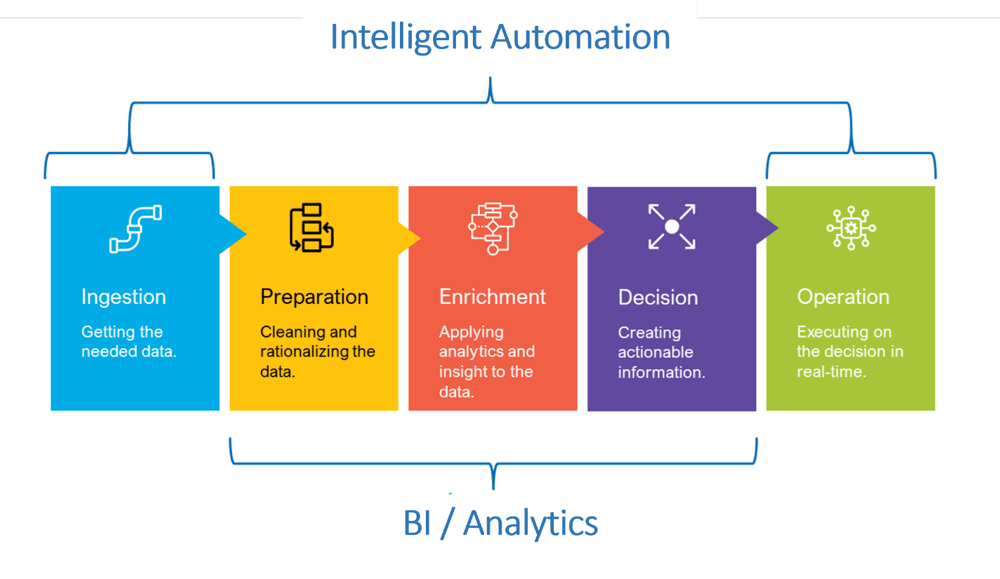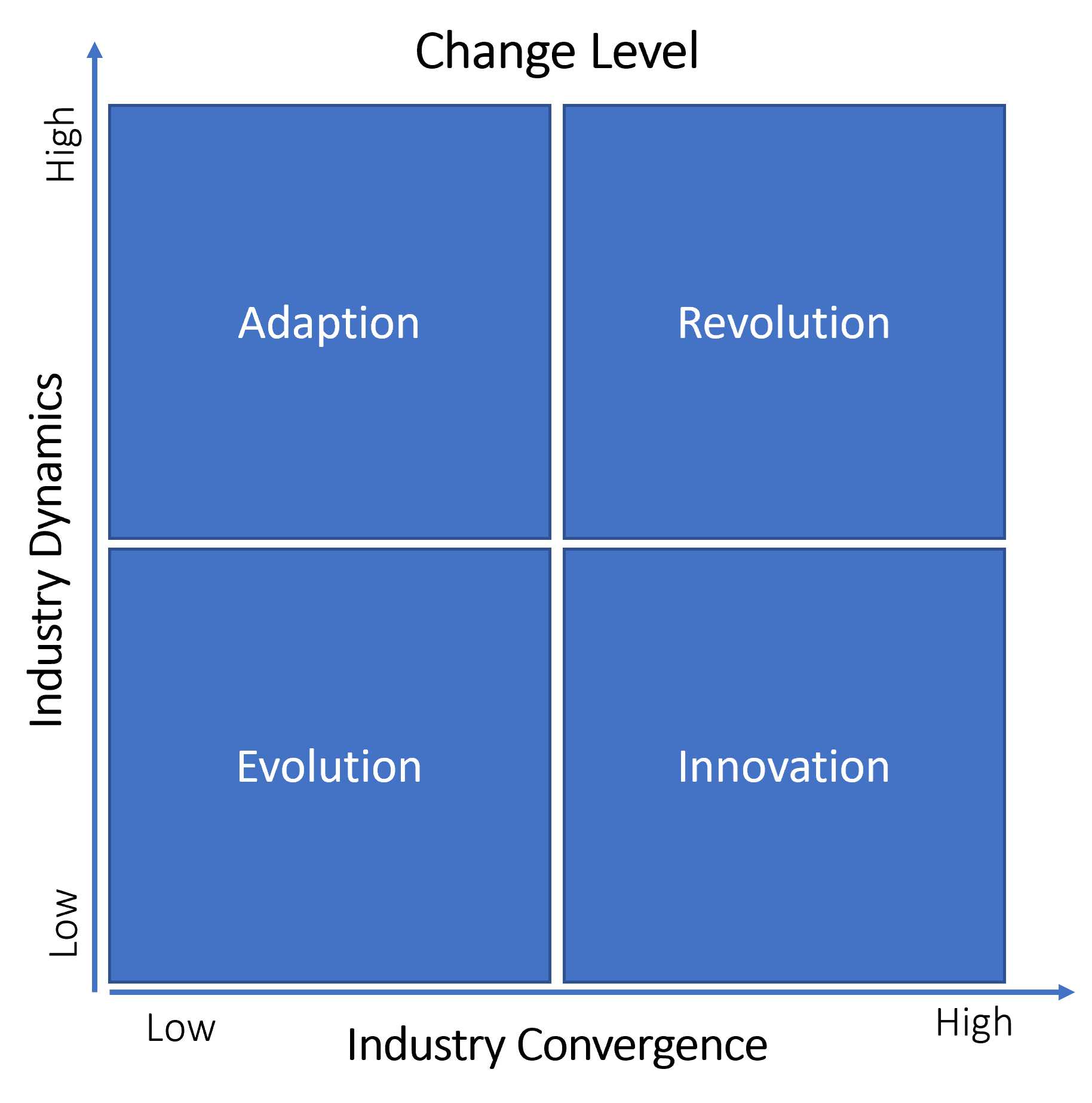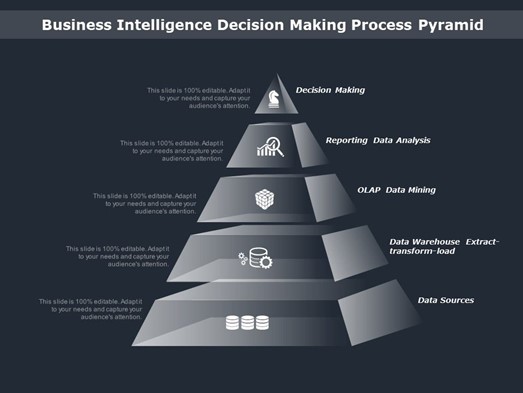Introduction
Decision Intelligence (DI) is the collective insight of Artificial Intelligence (AI) regarding data-driven analytics across a spectrum of information, including, but not limited to, business process, social media, economic, political, and cognitive data sets, which can provide an array of predictive and prescriptive recommendations ranging from operational next-best-action up to guiding business strategy. As broad and profound in scope as Decision Intelligence is, there is one key component missing – the ability to act. To leverage the insights of DI, through autonomous or semi-autonomous near-real time action-from-insight needs to be taken to make DI truly valuable.
Over the brief but spectacular history of AI, there has been a clear pattern of AI not being fully integrated into business processes. The barriers of culture, governance, cost, technical complexity, technical debt, training, business agility requirements and understanding of business value have all tempered the consideration and successful adoption of DI. However, one avenue that has proven to be flexible and intuitive enough for aiding in the commercialization of DI is through the employment of Digital Workers (DW) created with Robotic Process Automation (RPA). This approach helps bridge the chasm of how to appropriately incorporate the near real-time insights DI can provide and delivers business value to an organization.
Defining Decision Intelligence
DI’s origin is in data science. DI’s goal is to deliver data-driven business insights that drive better business outcomes. Compounding business analytics, DI expands the intake of information for analysis to include social science content, such as content from social media, along with advanced forms of decision theory to help generate insights on how to positively impact existing business processes.
Gartner defines DI as a “practical domain” of decision-making techniques which combine varied disciplines to influence decision models and processes. “Those disciplines include decision management (including advanced nondeterministic techniques such as agent-based systems) and decision support as well as techniques such as descriptive, diagnostics and predictive analytics.”i
As cloud computing becomes more prevalent, it continues to enable more powerful DI. Not only allowing for scaling processing and memory capacity on demand to perform DI analytics, but cloud services make it easier and faster to access streams of information from social media platforms and other data sources which feed into DI. Cloud services also provide an easier method to connect with an ever-increasing number of data sources through Application Programming Interfaces (APIs) and Platform as a Service (PaaS) offerings. Additionally, cloud services architectures allow for easier orchestration of automation, reusing services in different workflows and enabling easier spin-up and spin-down of automated work environments.
The cloud has also enabled an increase in the availability of more sophisticated, yet consumable, machine learning cognitive services, such as Optical/Intelligent Character Recognition (OCR/ICR), Natural Language Processing (NLP), vision services which identify objects, inventory and even individuals, which allow for data ingest by Digital Workers.ii In fact, the complement between Machine Learning (ML) services and Digital Workers become inseparable as business processes are developed to take advantage of ML services at scale and/or in near real time. Humans will increasingly be removed from the iterative interaction between ML and Digital Workers, as the proficiency of DI processes gain the trust of humans, allowing people to focus efforts on higher value endeavors.

Figure 1: The components and process of DI Automation
The expansive capabilities of DI are unleashing analyses that were previously unimaginable by most organizations. With DI, business leaders and power users can now gain access to these robust capabilities without advanced data science skills. More DI capabilities are available through low-code/no-code platforms that deliver graphical insights and drill-down analysis to make comprehension easier. Unfortunately, the last mile of transforming an insight into an action that can impact business outcomes is still gated by human interpreters and operational shepherds of DI. In many cases, it is still not practical to expect people to reliably take immediate action against DI insights with existing business processes.
How can people know if a DI insight will compromise business governance and risk requirements? How are they expected to insert the data points provided by DI into production processes, especially if those procedures require specialized access or levels of approval? The litany of exception handling that may be required to sustain the business processes being touched are often overwhelming for people to navigate, which is why many businesses are considering introducing Digital Workers into the DI ecosystem.
For organizations challenged by increasing complexity, the impact of the convergence of data, insight and action offered through DI can revolutionize business outcomes. It can more easily be conveyed graphically by plotting impact across the Value Quadrants shown in the figure below.

Figure 2: Value Quadrants for Decision Intelligenceiii
Choices and investments need to be made, which will dictate the applications of DI, business impact and the time-to-value from developing a DI strategy. As with any changes in business technology or process, there will be leaders and laggards – those who seek incremental gains, versus those who embrace the opportunity for transformational change. DI empowers organizations not only to accelerate or improve efficiency of current business processes but also to lay the foundation for generating net new business solutions so profound that they will likely lead to the creation of new industry segments.
How Digital Workers Become Intelligent Digital Workers
Digital Workers become more capable very much like human workers do – through training, experience, and feedback. At first DW training should not be focused on DI, but on business processes. Any data, access rights, policy requirements, exception handling, reporting and other execution requirements should be introduced to a DW on a Continuous Improvement/Continuous Delivery (CI/CD) basis. Just like people, don’t demand initial perfection of your DW, but focus on continuous improvement. Unlike people, Digital Workers will unwaveringly and consistently attempt to perform every tasked assigned to them and will generate a log of all successful and attempted tasks. These logs may be used as an additional source of data for process improvement, and over time, as another dimension of data to feed DI insights.
The depth of business logic instilled in a DW can eventually become robust enough to fulfill a business outcome by traversing an increasingly complex path, as directed by the process input and exception handling processes, to achieve a desired business outcome. This way Digital Workers can be ramped up and trained on how to safely accept DI insights as inputs, yet not deviate from respecting required policies and procedures in executing their tasks, as depicted in the diagram below.

Figure 3: Business intelligence Decision Making Process Pyramid (Qlik Active Intelligence)iv
It’s also important to recognize that DI requires aggregating data from disparate systems, and this process isn’t always easy. Digital Workers can increase access to centralized data and greatly reduce the manual, tedious work to ingest data required by analytical applications. Digital Workers can be trained to automate current manual data aggregation processes, including pulling data from legacy applications, mainframe, and so on. They can also more reliably extract data from websites and user portals on a more regular basis, as well as extract data from enterprise applications or Virtual Desktop interfaces or pull data from non-API sources. As Digital Workers take on more data ingest processes, DI will become more real-time, less error prone, and, if designed properly, much more secure.
How Digital Workers Help Broker Data via Intelligent Automation to Enable Decision Making
Digital Workers can wrap AI/DI insights with appropriate business logic and workflows to ensure that data governance, data quality, data management, as well as overall business services’ operations are accounted for in the last mile of service delivery, so that business processes can scale and maintain the flexibility needed in ever-changing enterprise environments. This approach enables a company to seamlessly adopt a best-of-breed ecosystem of DI partners, each orchestrated into action by DW carrying out increasingly complex business processes, while ensuring that the overall workflow maintains its integrity and is executed in accordance with corporate Risk & Compliance practices.
DW can be trained to leverage insights from AI vendors such as Alteryx and DataRobot, which offer specialized data sets, algorithm process templates, and a host of other products and services to enable customers to digitally transform their business processes. The sophistication AI vendors have developed around providing real-time access to data sets, like geo-referencing, down to a person’s location in an aisle of a retail store is almost as impressive as AI vendors integrating this information into predictive or prescriptive algorithm regarding a potential customer’s needs.
It would be a fool’s errand to list all the use cases that can be built leveraging DI insights, as there are virtually no limits for automating intelligent processes, especially as it is becoming increasingly common to see AI/ML functions being offered as PaaS services by the major cloud services providers. The real focus should be on how to actualize and commercialize the insights these vendors provide in the most consumable way by industry and organization, so that they can provide business outcomes of value.
Digital Intelligence at Work
Below are a few examples to demonstrate the varied ways DI and Autonomous Automation can be part of building new business cases, delivering disruptive solutions to address business challenges.
A global retailer, to address an Inventory Management challenge, restructured their business process to have a DataRobot ingest historical sales data to predict customer demand by store, and trained DW to use the resulting insights as triggers for executing orders. The results were twofold:
- Invoice Processing saw DI predicting which invoices have the highest likelihood of default and had DW act on this data by prioritizing high-risk invoices for follow-up.
- Customer Churn Reduction by having DI analyze data from Salesforce to predict which customers are most likely to churn in the next 3 months, and have DW act on this data by prioritizing these high-risk customers in marketing campaigns.
Why is this important? Forrester found that it costs five times more to acquire new customers than it does to retain existing customers, while Bain & Co reports that a 5% increase in customer retention produces more than 25% increase in profit.v
Another example use case involves a top fast-food chain that recently leveraged Alteryx and Blue Prism to reduce time spent processing tax data for 1099-Ks from 10 hours to 10 seconds. This enabled their tax professionals to have more time to look through tax data and discover opportunities to increase revenue, widen margins, and reduce errors.
Blue Prism digital workers automatically move data from the company’s ERP system into Alteryx, eliminating the need for tax and data professionals to manually input the data, which then quickly combines the data from various sources while also identifying components that are in one set and not another, so the system can alert the team to data errors they might otherwise never find. The platform then automatically formats, validates, and outputs the clean 1099 data onto a fresh spreadsheet. The result is that they protect customers from being impacted by poor data/human error scenarios, leveraging powerful analytics capabilities to uncover opportunities and errors within the company’s data in an automated fashion. Alteryx processes the data quickly and effectively, then spits it back to Blue Prism, which sends emails to the parties who need to know what was done with the data—again saving time by eliminating manual steps.
A third example focuses on a major North American payment processing service provider that needed to import 175,000 new accounts into Siebel, including the printing of 1.1 million cards. Their existing process only allowed for twenty-five thousand total accounts at a time and would have taken six months to finish. Additionally, their data was not ready, and needed to be cleaned.
Trifacta, an AWS tool available via Amazon Machine Image, was leveraged to efficiently clean the data without involving IT services, which fed into a DW-based import engine that could import files 24/7, leveraging built-in error control and reporting for easy tracking.
The outcome was that Trifacta reduced the 7-week data cleansing process to 1-2 weeks while Blue Prism’s Digital Workers cut the 10-week migration down to 4 weeks. The solution enabled the customer to complete their Siebel import on-time with no additional impact to the business and provided a new process to import new accounts.
Getting Started with DI
Companies can benefit greatly by implementing DI and RPA. When the two are brought together, business benefits are amplified. Digital Workers augmented with Decision Intelligence can be a central enabler of any organization’s digital transformation. Doing this properly involves considering the “Art of the Possible” and defining a vision for an Intelligent Automation solution. The bolder and more disruptive the vision, the greater the value that may be achieved.
It’s critical to begin with a robust strategy and design that incorporates DI to achieve better decisions and insights for the enterprise that are acted upon in a more reliable and timely manner. Here are some suggested next steps for unlocking the power of DI to take your organization into the future:
- Plan to achieve business outcomes that can be understood by business leaders through quantifiable metrics, which can be used to report on DI initiatives.
- Be sure to design transparency into DI solutions so that what is delivered can continue to be understood and leveraged through a CI/CD.
- Model your DI solutions as an interplay between RPA and DI platforms, so that a modular and reusable methodology can be enabled for a wider adoption and application of DI across your organization.
Get going. Automating actions based upon Decision Intelligence is the future, and the future is here!
About the Authors

Eric Maloney is a Digital Transformation Strategist with Axis Group based in New York. He has more than a decade of experience as a Consultant in Project and Program Management, primarily in the Financial Services and Insurance industries. He spent over five years as an Infrastructure Architect and Solutions Architect at JP Morgan Chase, followed by over eight years as a Data and Storage Strategist with NetApp and EMC. He joined Microsoft as a Global Account Technology Strategist serving Morgan Stanley, then as a Digital Transformation Lead for Financial Services and Insurance customers. Prior to joining Axis Group, he was Intelligent Automation Strategist at Blue Prism serving their Advisory Partners. At Axis Group Eric’s goal is to educate customers and partners about the "Art of the Possible” when exploring Intelligent Automation and its impact on the future of work. Eric earned his PhD. In History from the State University of New York at Stony Brook.

Brad Hairston is the Advisory Alliance Director at Blue Prism. Based in Dallas, TX, Brad supports Blue Prism’s top advisory firm partners in helping their clients utilize intelligent automation to solve operational issues and innovate across the enterprise. He joined Blue Prism, the global leader in intelligent automation, at the end of 2018. Prior to Blue Prism, Brad spent nearly 30 years in the consulting industry helping companies effectively utilize technology to execute business strategy in both private and public sectors.
Blog References:
(i) Cognitive Services and Machine Learning - Azure Cognitive Services | Microsoft Docs, Machine Learning - Overview of Amazon Web Services, https://cloud.google.com/products/ai/
(ii) Cognitive Services and Machine Learning - Azure Cognitive Services | Microsoft Docs, Machine Learning - Overview of Amazon Web Services, https://cloud.google.com/products/ai/
(iii) Source: decisioningelligence.org
(iv) Source: BI & Data Trends - Qlik® - Download the 2022 eBook - qlik.com
(v) https://go.forrester.com/what-it-means/ep04-rethinking-customer-loyalty/
With 25 years of experience, Axis Group delivers innovative data and analytics solutions and services to enterprise organizations. Axis Group meets companies on their digital transformation journeys to improve digital literacy and data fluency. Focusing on each company’s unique culture and digital maturity, Axis Group drives analytics adoption to enable self-sufficiency resulting in smarter teams and better business outcomes. Axis Group combines business acumen, leadership, and industry-specific experience with technical expertise to tackle the toughest data problems. Axis Group is The Enablement CompanyTM.
